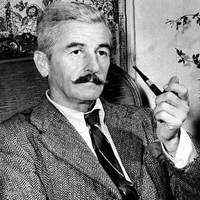Multiple Voices and Perspectives in As I Lay Dying
William Faulkner has made use of multiple voices and perspective in As I Lay Dying. The novel is a series of monologues of fifteen characters. The monologues of some characters are repeated. Altogether fifteen characters narrate the story. The narrative voices of some characters have been repeated by Faulkner. Seven of the narrators are Bundrens and the other eight narrators are outsiders.

William Faulkner (1897-1962)
The seven narrators from Bundren family are Anse Bundren, Addie Bundren, Cash Bundren, Darl Bundren, Jewel Bundren, Dewey Dell Bundren and Vardaman Bundren. Other eight narrating voices are the voices of Whitfield, Vernon Tull, Core Tull, Dock Peabody, Samson, Armstid, Mosley, and Skeet MacGowan. In this way Faulkner made use of the narrating voices of fifteen characters altogether.
By including the voices of several Bundren members, William Faulkner wanted to convey Bundren members' reactions to the death of Addie Bundren. More than conveying different reactions of Bundren children to their mother's death, Faulkner presented the intensity of reaction, the emotionality of reaction, the heightened effect of the tragic fact.
From Anse Bundren's reactions we come to know several of his weaknesses as a husband and as the head of the family. Clumsiness and laziness are hallmarks of his demeanor. Selfishness is the distinguishing characteristic of his personality. To show how, such a kind of husband reacts to the death of his wife, William Faulkner made use of the subject perspective.
To show how an innocent child reacts to his mother's death, Faulkner used the voice of a child who has become a narrator in the story. To show how a psychologically retarded son responds to the death of his mother, Faulkner used the psychologically retarded narrating voice of Darl. To convey how the most beloved son of a mother reacts to the death of his mother, the novelist presented the subjective view of Jewel who heroically fights for completing his mother's funeral. In this way to display the diversity of Bundren members' reaction to the phenomenon of death, Faulkner used the first person narratives. By a bunch of diverse responses of Bundren members William Faulkner managed to thematize the phenomenon of death. In other words Faulker used the first-person narrative monologue to shape the notion that's death is not as a phenomenon, but as a tragically troubled responses to the effect of this phenomenon on those who are associated with the dead directly or indirectly.
The responses of family members to the death of their one of the family head is sure to be colored by subjective biases and prejudices. To give a touch and twist of objectivity to the reportage on the death of Addie, Faulkner included eight narrators outside the Bundren family. Even there are lots of elements of prejudices in the storytelling of those outside character-narrator. For the most part, the report about the Bundren odyssey on the way to Jefferson is somewhat objective. The family members' and outsiders' reportage about Bundren adventure maintain a sort of balance in the experimental fulcrum of the novel.
The strikingly unique hallmark of As I Lay Dying is the characters in the novel narrate the story. This is one of the most innovative breakthrough in the advancement of experimental modernism. The multiplicity of voices and the perspective of first-person narrative contribute a lot to the fictional effect on the reader. In As I Lay Dying, it is the characters who narrate the story. Each character infuses his/her own subjectivity into the account of the story he/she narrates. The readers of this novel have to isolate the true account of the story from the imposed and infused subjectivity of characters. To identify the true account of the story from the added, Subjectivity of the characters, the readers have to participate in the novel. That is why this novel has been called the reader-participation novel. Without participating in the novel the readers can't make out any consistent meaning of the novel. Hence the novel As I Lay Dying does not produce that kind of fictional effect which conventional work of fiction produces. This novel by William Faulkner produces a technically sophisticated factional effect on its readers. One critic has said that ninety nine out of hundred can succeed in deserving aesthetic pleasure by studying this novel. Hence, the novel cannot produce an aesthetic impact on its readers. On the contrary, it produces a complicated impact on its readers. That does not mean the novel has lost its aesthetic charm and thematic impact.
Literary Spotlight
Introduction of As I Lay Dying
Plot Summary of As I Lay Dying
Themes in Faulkner's As I Lay Dying
As I Lay Dying a Masterpiece of Faulkner
Symbols in Faulkner's As I Lay Dying
Faulkner's As I Lay Dying as a Modern Text
Faulkner's Style in As I Lay Dying
Narrative Technique in Faulkner's As I Lay Dying
 |
bachelorandmaster.com |